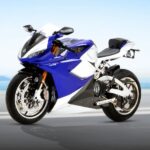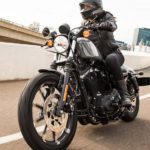When it comes to motorcycles, even those who have never thrown a leg over a bike are bound to recognize a few of the industry’s best-selling models. Take the Harley-Davidson Sportster, for example. With over 40,000 units sold in 2020 alone, the iconic bike can easily be found weaving through traffic from coast to coast. On the international market, the Honda Super Cub is the undeniable best-seller, with the Japanese brand moving over 100 million units since the model first debuted in 1958.
Affordable, popular, and easy to modify, these two models might be accessible, but they’re also about as rare as a crossover SUV in a grocery store parking lot. What does a rider have to do to set themself apart from the crowd? The history books are full of rare, limited-run bikes that, for one reason or another, never entered widespread production. Designed for racing, record breaking, or testing out new concepts and designs, these bikes tend to command a high price, if they can be found at all. Join us as we take a look at some rare motorcycles from days gone by, ranging from envelope-pushing D.I.Y. rigs to modern carbon fiber models that are more aerodynamic than your average fighter jet.
1916 Traub
When you’re talking about rarity, it’s hard to beat a one-of-a-kind model like the mysterious Traub motorcycle. The year is 1967, and a family living in the Chicago suburbs is forced to call in a plumber after springing a leak in the basement. The job necessitates partially removing a brick wall in the basement which, in a twist that Edgar Allen Poe would certainly appreciate, reveals a previously unknown room containing a vintage motorcycle. Emblazoned with the name “Traub” and dated to around 1916, the motorcycle was perfectly preserved for over 50 years.
If you’ve never heard of the Traub brand, you’re not alone. The bike’s origin stumped motorcycle enthusiasts and automotive historians alike until North Carolina’s Wheels Through Time Motorcycle Museum solved the riddle once and for all. After being unearthed, the Traub was traded to a Chicago motorcycle dealer for a $700 Suzuki and later purchased by legendary stuntman Bud Ekins before ending up in the hands of Dale Walksler, founder and curator of Wheels Through Time Museum. After pouring over historical sources like the archives of Motorcycle Illustrated, Walksler traced the unique bike back to one Richard Traub, a self-described “experimental machinist” who lived at the property where the bike was discovered until the 1950s. Walksler discovered a 1910 letter to the editor of Motorcycle Illustrated in which Traub recounted his experience working on a new 275-pound, four-horsepower V-Twin motorcycle in his spare time.
Of course, tinkering with a project bike is nothing new, so what made the Traub so special? In a word, complexity. Traub’s design was remarkably advanced for its time, employing techniques and components that wouldn’t enter the motorcycle mainstream for decades to come. More advanced than any production cycle of its time, the Traub employed a twin-cam design some 80 years before Harley-Davidson, and was powered by a massive, hand-built 1200cc engine paired with an innovative three-speed transmission. With a top speed of 80 mph, the Traub could likely outpace any bike of its era, which is especially impressive when you consider that it was built by one man. For a little context, just imagine a modern hobbyist producing a hand-built supercar in their spare time. Traub was undoubtedly an engineering genius, but when World War I called, the inventor made for the battlefields of Europe. The original motorcycle was likely bricked up shortly before his departure and, for reasons known only to Traub himself, would stay there until the fateful plumber came calling more than a half-century later.
1939 Crocker “Big Tank”
Speaking of V-Twin visionaries, enter Albert Crocker. The designer kicked off his career as a dealer and representative at Indian Motorcycles before striking out on his own in the 1930s. While Crocker initially focused on speedway motorcycles, he started tinkering with more road-focused designs with an early V-Twin model in 1936.
The hand-built motorcycles were based around the 1000cc, Hemi-head V-Twin Indian engine that Crocker knew so well. The powerful engine managed to produce some 60 horsepower, which was quite the accomplishment at the time. For a little context, the fastest Harley-Davidson models of the era typically maxed out around 40 horsepower, proving that Crocker knew a thing or two about maximizing power. The designer would eventually gravitate towards his own 1000cc, OHV design with Hemi heads and aluminum casings. This was the same engine that would grace the legendary 1939 Crocker “Big Tank”.
With a production run limited to just 100 models, the Crocker “Big Tank” was about a lot more than just a brawny engine. Largely considered to be one of the first factory custom bikes to hit the market, the 1939 Crocker featured a distinctive scallop paint job, not to mention the polished cast-aluminum fuel tanks that would give it its name. Lower and sturdier than many other bikes of the time, the 1939 Crocker capitalized on the emerging “chopper” trend to give riders a one-of-a-kind bike that would become an instant classic. An estimated 68 Crocker “Big Tanks” have survived to this day, and they tend to command an eye-watering sum at auction, with a recent sale topping $700,000.
1966 Honda RC 166
When Honda’s racing division dove into the Grand Prix racing scene of the 1960s, they knew that no half-measures would do. In a bid to compete with the increasingly powerful bikes of the day, the Japanese brand pulled out all the stops to produce the RC 166. Powered by a 250cc six-cylinder engine, the RC 166 could rev up to 18,000 rpm, giving it a distinct advantage in its class and leading to no shortage of podium-topping finishes throughout the 1966 season.
The RC 166’s dominance was about more than just its powerful six-cylinder engine. With a top speed of more than 150 mph and an output of 60 horsepower at 18,000 rpm, the motorcycle was leaps and bounds ahead of its rivals, earning a loyal following and producing an iconic whine that made it easy to recognize. Honda engineers also employed a novel design with a 45-degree angle between the cylinders, with the approach giving the RC 166 improved aerodynamics over many of its competitors.
The RC 166 would go on to win the 1966 250cc World Championship with ten first place finishes under its belt. Honda would withdraw from the class the following year, leaving the bike with a spotless win record and etching its name in the history books. Reserved for the racetrack and Honda’s team riders, the RC 166 never entered widespread production. As few as 25 units might have been produced, allowing the RC 166 to command a high price on the secondary market. The bike has sold for as much as $1 to $1.5 million when it’s gone up for auction, making it the second-most expensive motorcycle in history after our last entry.
2008 Ecosse Spirit ES1
When two Formula 1 designers try their hand at creating a superbike, the results are bound to be thrilling. At least, that’s the case with the Ecosse Spirit ES1, an ultra-rare motorcycle that easily ranks among the rarest and most expensive in the world. Limited to just ten units, the Ecosse Spirit ES1 carries an equally exclusive price, with one model selling for $3.6 million in 2020.
What could possibly make a motorcycle so valuable? Designed to be as light and aerodynamic as modern engineering will allow, the ES1 features a frameless chassis wrapped in ultra-light carbon fiber. Weighing in at just 265 pounds and boasting a 1000cc, four-cylinder engine good for some 200 horsepower, the motorcycle has an insane power-to-weight ratio that would make some supercars jealous.
Designers Don Atchison, Richard Glover, and Andy Le Fleming put aerodynamics front and center in designing the ES1. They also recognized that no matter how much carbon fiber and wind tunnel testing you do, the rider is always going to be a limiting factor. To get around this age-old issue, the ES1 team set about changing the rider position entirely, moving the seat to a lower position that brings the knees and feet closer to the body. On a normal bike, this approach would clash with the front of the bike’s swingarm, but designers envisioned a new gearbox featuring a drivechain that exits through the center, connecting to a shaft in the swingarm that drives a second gear feeding the chain to the wheel. The result is a narrower swingarm, which allows a rider to hunker down on the bike and improve its overall aerodynamics. This design, along with a newfangled suspension and redesigned control mounting arrangement, set the ES1 apart from the crowd, allowing riders to reach speeds up to 240 mph, if they dare.
From the first factory custom bike and immaculate RC 166 to the slippery ES1 and the engineering marvel that was the Traub, rare motorcycles provide an interesting glimpse into history. These models might not have been around for long, or simply not made available to the public, but each has certainly had an impact on the industry as a whole. Whether they were ahead of their time, impractical outside of the racing circuit, or simply too expensive for the mass market, these motorcycles represent some of the most intriguing artifacts the industry has ever produced. The Traub saga alone is worth its own Hollywood screenplay, with an unknown hobbyist producing a game-changing design the likes of which wouldn’t be replicated for years to come. These models might have been a flash in the pan when compared to long-standing favorites like the Harley-Davidson Sportster or Honda Super Cub, but that doesn’t mean they were any less influential.




